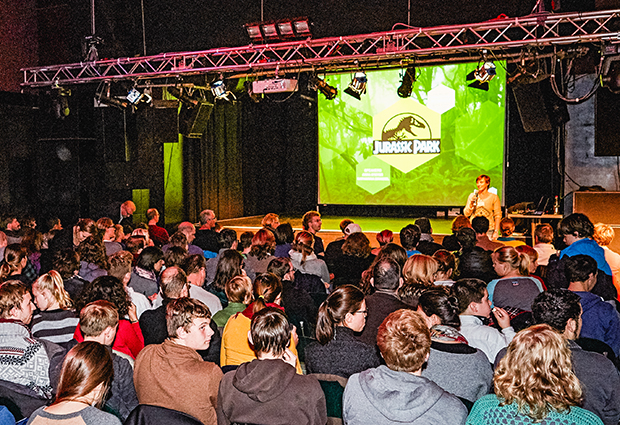
Read the latest Issue
Two EMBL PhD students sink their teeth into the science and speculations of Jurassic Park, for the benefit of two-hundred cinemagoers.

In 1993, Jurassic Park roared into cinemas, bringing dinosaurs back from extinction in a dazzling and now-classic cautionary tale of genetics (not to mention prehistoric predators) gone awry. In the second EMBL Science Movie Night, it was the task of Anna Steyer and Katharina Zirngibl to debunk the myths of dino DNA, cloning and genetic engineering. In the process, they challenged their own knowledge and understanding of key themes and controversies in the life sciences.
Explaining complex scientific concepts to a non-expert audience is a tricky task. In Jurassic Park, the cartoon character ‘Mr DNA’ – a whimsical animated double-helix strand – educates visitors on how the Park’s dinosaurs are recreated. EMBL’s two Miss DNAs, Steyer and Zirngibl, took this as a cue to discuss DNA sequencing and recombination, becoming as fascinated by the topic as their audience.

In the two decades since Jurassic Park took its first bite of the box office, genetics has evolved significantly. Scientists have now calculated that we’re nearly 60 million years too late to recover any traces of fossilised prehistoric DNA. “The stability of genetic material, what factors influence this and why, and from how far back one can isolate DNA – this was all new to me,” says Steyer. For more recently extinct animals, however, fiction is getting closer to fact: “It was surprising to share that a Russian team is close to cloning a mammoth, in combination with elephant DNA.”
In the process of preparing the talk I approached the topic from different and new perspectives – I learnt a lot.
“As a computational biologist, I thought I knew a lot about the process of genetic sequencing,” adds Zirngibl, “But once you start thinking about the details, about how and why, many more questions arise.” To capture the audience’s imagination, she explained that DNA sequencing chips contain up to two million holes, each around the width of the finest human hair. “In the process of preparing the talk I approached the topic from different and new perspectives – I learnt a lot.”
Entombed genetic material, impossible DNA puzzles and transgenic eggs makes for fascinating if fanciful science; but the speakers also aimed to highlight the relevance to modern biology and life. The remarks of Jeff Goldblum’s character prompted a discussion about the reality and regulation of cloning: “God creates dinosaurs – God destroys dinosaurs – God creates man – Man destroys God – Man creates dinosaurs.”
It’s not about changing minds, but informing judgments.
When Jurassic Park debuted, science was still three years away from a landmark in cloning technology: Dolly the sheep, the first cloned adult animal. Since then, cloning and genetic technologies have advanced apace. Describing reproductive and therapeutic cloning in turn, the duo presented the scientific context of this contentious topic. “People have too little time to read up on everything, so these events are the perfect opportunity – it’s not about changing minds, but informing judgments,” Zirngibl explains. “It’s also important to show that researchers are aware of the ethical rules and regulations, and the implications of their work.”

“We were well-prepared for difficult questions about cloning, but the audience was there to be informed and entertained, not to criticise or condemn,” says Steyer. “The topic of cloning is old hat for many of my colleagues, but to see the interest and openness of the audience was encouraging and inspiring.”
Closing the gap between researchers and the general public is a key goal of EMBL’s Science Movie Nights. Hosted in Heidelberg, Germany, in the local language, this Friends of EMBL initiative seeks to illuminate the science in popular cinema, and inspire interest by showing that research is relevant and fun. All 220 seats at the city-centre venue were filled, creating a unique setting for the speakers as well as the gathered crowd. “Until now, I’d I only presented to my research group,” says Zirngibl, “This was, by far, my biggest audience.”
I never expected to need to translate ‘DNA pellet’!
With careful planning and preparation, the speakers were able to contend with some unexpected challenges – Steyer reveals: “Since our working language is English, at times it proved surprisingly difficult to find the right German words: I never expected to need to translate ‘DNA pellet’!” The audience provided a warm reception, and myths were dispelled on all fronts. “We had a great, responsive crowd, ranging from school children to retirees,” she concludes. Unlike the mighty prehistoric protagonists of Jurassic Park, the event successfully proved that neither scientists nor the general public bite!

Looking for past print editions of EMBLetc.? Browse our archive, going back 20 years.
EMBLetc. archive